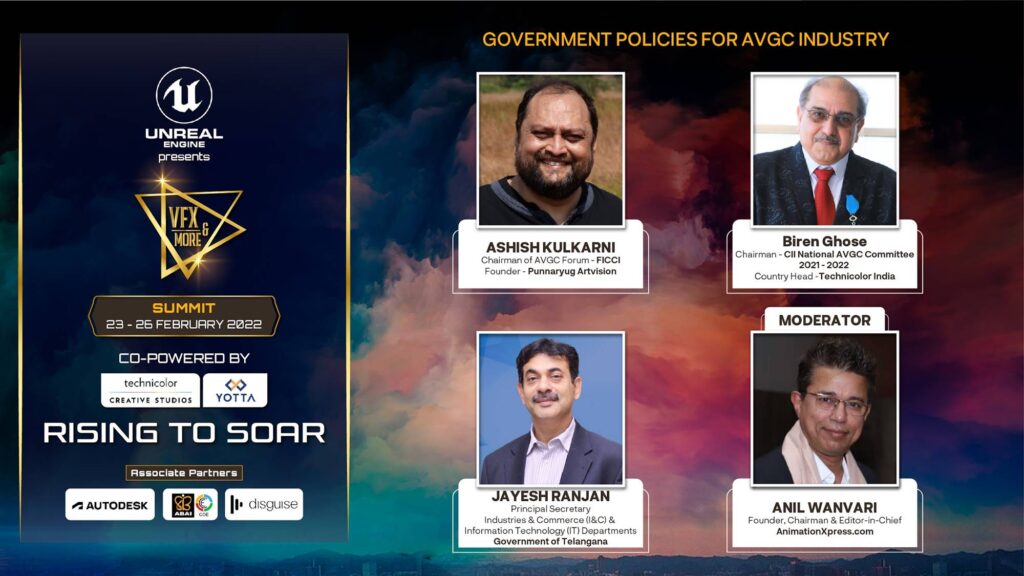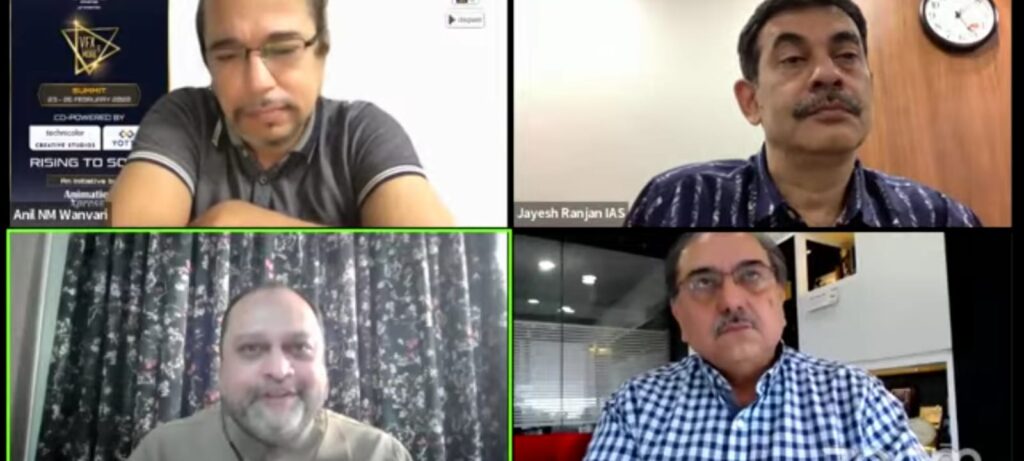
First day of the VAM Summit 2022 began with the sessions ‘Government policies for AVGC industry’ where the panelists shed light on the government policies for AVGC sector and how they help to develop and empower the AVGC industry. The speakers included FICCI AVGC forum chairman and Punnaryug Artvision founder Ashish Kulkarni, CII National AVGC Committee chairman and Technicolor India country head Biren Ghose and Government of Telangana principal secretary of Industries and Commerce (I&C) and Information Technology (IT) departments Jayesh Ranjan. The session was moderated by AnimationXpress founder, chairman, and editor-in-chief Anil Wanvari.
The discussion kick-started with Ranjan mentioning why Telangana Government focused to promote and empower the AVGC sector in their state and how the state is building the IMAGE tower to provide a quality platform and introducing other initiatives for the growth of the AVGC industry. He shared, “Telangana is a new state created in 2014, and we have given complete freedom to all to identify their priorities and create their own policy. Nothing from the past can tie them, there is no legacy. We had to look at everything as a clean slate. When we were designing our IT policy in 2014, we got to know Hyderabad has a reasonably sized AVGC industry with huge potential. While writing the policy we felt that this sector needed much focus. In 2016 we introduced a sectoral policy on cyber security and the AVCG industry.”
He further added, “Our policy is made with a lot of expert discussions and we did many bottom kinds of exercises to understand what were the difficulties the company face and every sentence in our policy document is attempting to solve their pressing needs and the requirement of the industry. When you look at Telangana’s AVCG sector, it is built by 85 per cent of mid-scale companies. When we had a discussion, we came to know that these mid-scale companies want to be in Cyberabad, which is the most happening place in Telangana where major IT sectors are located. While writing policy we decided to create the highest quality space in Cyberabad and make it available to all the AVGC companies at throwaway prices. We are the first government to spend so much money to build an Image Tower in 1.4 million sq ft to empower the AVGC sector.”
Ranjan also highlighted that the Telangana AVGC industry has global footprints and has much potential to contribute to the Indian economy. There are a lot of new players coming to Telangana to set up their studios, academies to empower the local skills. “Our policy is also focused to boost employment in the state, and we are also aware how IT employments are biased towards BTech and engineering degrees. But AVGC has the flexibility to empower even the school dropouts, graduates; all you need is creative talent.”

Talking about the importance of government support for the AVGC sector, Kulkarni shared, “When you look at the particular vertical within the industry, it requires a hand-holding for very critical small-small issues the industry faces. When you look at the skilling aspect, the skilling has to really go to tier-2, tier-3 cities as well. The basic requirement to be in our industry is creative art, performing art, writing skills, design, and many more. These skills are available in rural areas and they have original thinking. Urbanisation kills many of these original thinking mechanisms. It structures your mind in a very different way. This is the reason that when you see reality shows, most of the talents come from rural areas. People always find a way to make a place in the industry and this is where the support from the government is required.”
He further added, “When India got its independence, we had set up our education policy. We wanted India to be an industrial nation. We set English, Maths, Science, Social as tactile subjects, we forget about creativity, performing arts, designing, and sports which is the most significant, balancing factor and sub-parallel level playing field for most of the people. Being literate alone in this country is not enough; and even if you are not literate but creative at the same time, you will still struggle for your life. It is about bringing about balance. Soft power also brings unique storytelling features that industry requires, and that’s why government intervention is important. Our industry is always compared to IT, but not to forget that when IT happened the IITs, private engineering colleges, and all the forces are already there. But our industry which has 106 years of history and with India becoming the largest filmmaking country in the world, we still don’t have the education institutes formally supporting and for this government intervention is required.”
Kulkarni also lauded the Telangana initiative regarding Image Tower and how the leadership there listens to the AVGC industry and helps them to flourish as an industry.
Adding to what Kulkarni said, Ghose mentioned, “Government has to do the heavy lifting of building roads. We – the industry and the citizens – will buy the car, drive on it and make business for ourselves and the country. Government should look at the media and entertainment sector as an infrastructure industry. If we create basic enabling infrastructure in 10 to 15 cities, then people can come and play on the platform.”
He also added, “It is important to see how to create a network effect. Any country whether it is Korea, UK, Canada has been able to create a network effect by cross-connecting the independent entities in TV, OTT, games, media, academia and other platforms. We need to have deliberate and strategic inter-connection.”
Ghose highlighted what is education vs skilling, what are products vs services, what is ownership vs management, funds vs grants, and how synergy happens. He also shared the investment data and values spent on OTT in the current year. “The Indian players Zee5, Voot, MX player had done extremely well. If you look at it and there are many production houses that have more than 15 per cent as their VFX budget. The conservative 15 per cent indicates that we had huge thousand crores of revenue around OTT in the last year. We always compared VFX with big tentpole movies with thousand of shots like Robot , Ra-One, Baahubali but don’t forget the revenue of the film in our country is nine per cent of our total M&E. If the trajectory that everyone puts together goes in its direction, we will be 1.15 billion within next seven years,” Ghose shared.
The panelists discussed the tariff cuts and subsidies to the AVGC industry. Ranjan shared, “If the mid-scale companies have to compete against the big boys of the world, they need some support and affirmative actions. In our policy after a lot of thought and deliberation, we decided to provide the bare minimum which bridges to fill the gap between them and the bigger players. We offer four kinds of financial incentives; when you come to Image Tower, it will be taken care of. When an outsider occupies private real estate for your AVGC company, then we pay 25 per cent of their rent, similarly, we give them power tariff benefit. The most important benefit provided by us is that if someone creates an IP we completely bear the cost of the entire process of getting the IP.”
Ranjan also highlighted how the AI sector is the future and it was believed that AI and machine learning will contribute about 500 billion in our promised five trillion economy. He believes that government and the industry should help the smaller players to climb the growth ladder and also lauded an association named TVAGA (Telangana VFX, Animation and Gaming Association) which helps smaller companies to climb the technology ladder.
Kulkarni and Ghose insisted Ranjan throw some light on T-hub which is an innovation intermediary and business incubator based in Hyderabad. It is a partnership between the Government of Telangana, three academic institutes in Hyderabad, and the private sector. Ranjan added, “T-hub is an institution to promote innovation and entrepreneurship, TASK is an institution which promotes skilling and encourages students to choose a correct career path. The reason behind creating this institution is that the biggest criticism the government policies face from the people is that they read very well on paper and nothing happens on ground. We opened the institutions to support our policy and to run the institution we bring the best talent from the open market.”
Kulkarni signs off the session by underlining the government intervention in developing the creative education system and introducing different Ph.D. programs for all the possible creative-oriented fields. He believes that if we, as the industry, work together and educate each other then we can achieve miles together.

